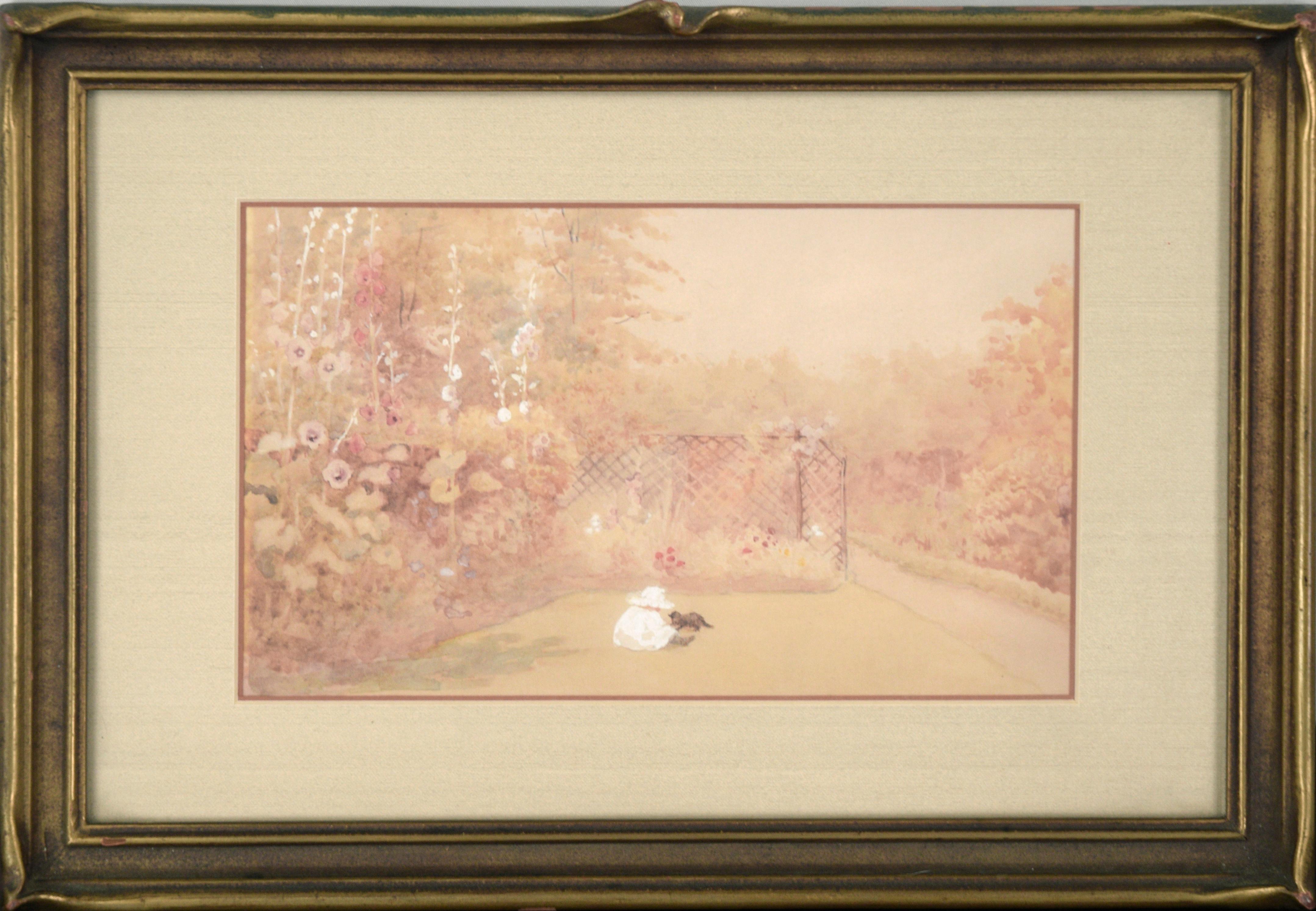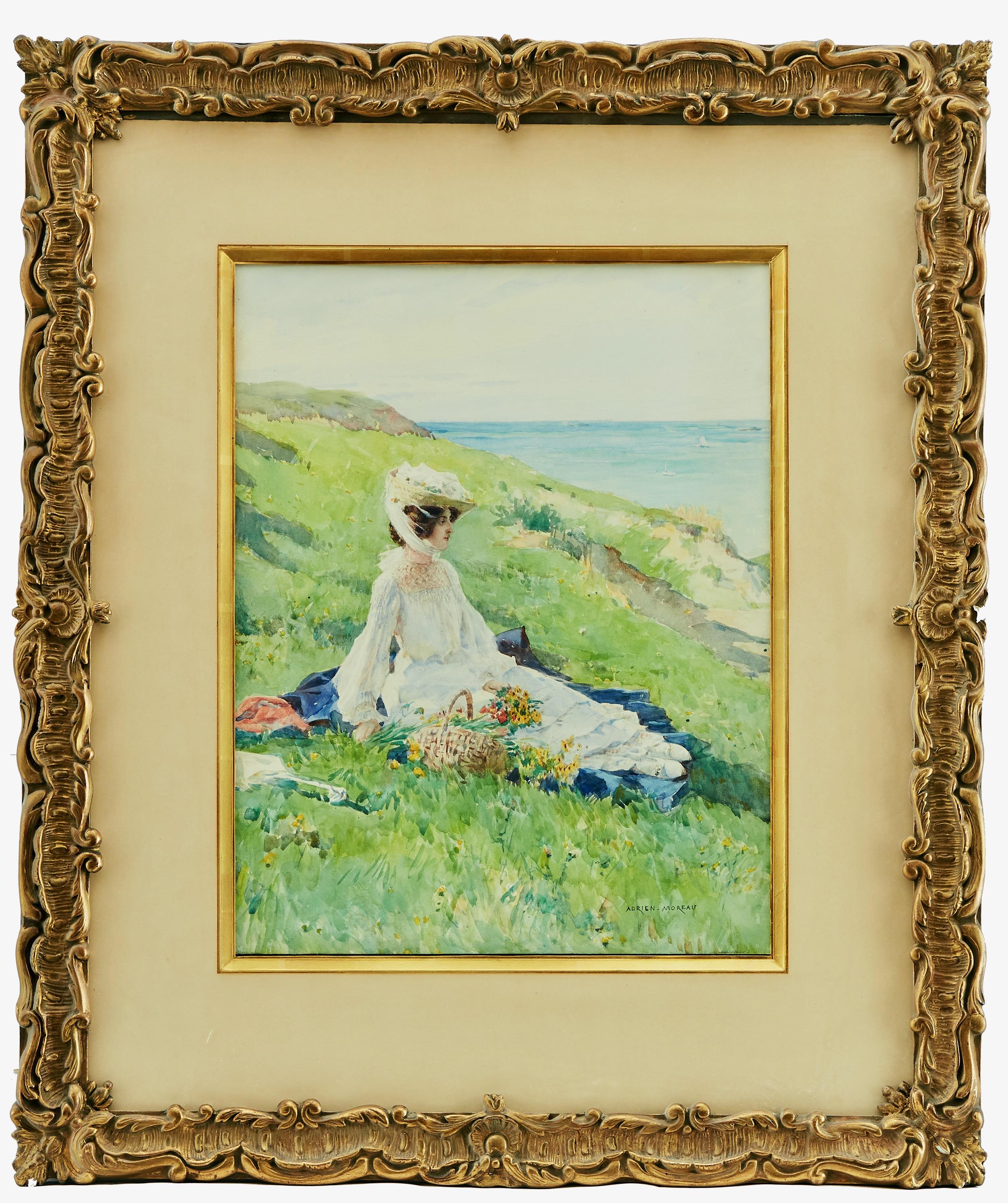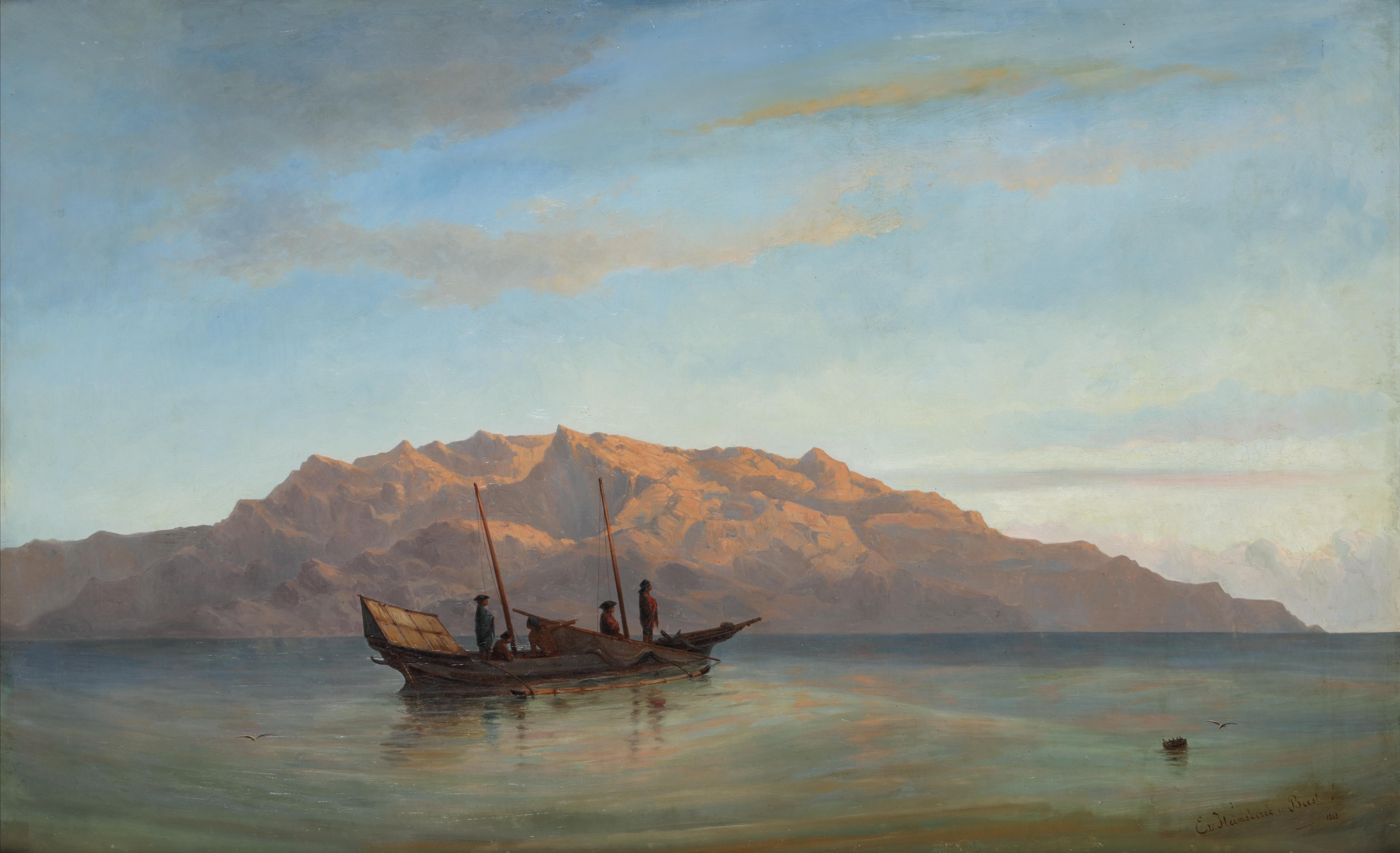Items Similar to 'The Greek Temples of Paestrum' by Paul Albert Girard, Paris 1839 – 1920, French
Want more images or videos?
Request additional images or videos from the seller
1 of 8
Girard Paul Albert'The Greek Temples of Paestrum' by Paul Albert Girard, Paris 1839 – 1920, French1839 – 1920
1839 – 1920
About the Item
Paul Albert Girard
Paris 1839 – 1920
French Painter
'The Greek Temples of Paestrum'
Signature: Signed lower left
Medium: Aquarelle
Dimensions: Image size 29 x 49 cm, frame size 41 x 61cm
Provenance: Paestum, designated as a UNESCO World Heritage Site, stands as the best-preserved Greek archaeological site in Italy. Situated just south of Salerno, near the picturesque Amalfi Coast, and in proximity to Pompeii, Paestum remains somewhat undiscovered by many travelers.
In its prime, Poseidonia thrived, evident in the remnants of city walls, colossal temples, and the overall urban layout. As Magna Grecia expanded and established trade routes, conflicts arose between the Greek colonists and the indigenous Samnite and Lucani tribes. Archaeological findings, however, suggest a period of peaceful coexistence between the Greeks and the Lucanians.
This harmony was disrupted in 273 BC with the arrival of the Romans. The Romans, while altering the city's name to Paestum, did not obliterate it. Remarkably, their admiration for the splendidly constructed temples played a role in shaping classical architecture on the Italian peninsula, influencing subsequent Roman development and style. The Romans made additions to Paestum, including a forum, an amphitheater, a temple of their own, and residential structures, some of which still stand today.
In 79 BC, the eruption of Vesuvius dealt a partial blow to Paestum, altering its landscape. Despite this setback, the city's survival attests to its resilience and enduring cultural significance. Today, visitors can explore the fascinating remnants of Paestum, a testament to the confluence of Greek and Roman influences, and the architectural prowess that has withstood the test of time.
Born on December 13, 1839, in the artistic heart of Paris, Paul-Albert Girard emerged as a luminary in the world of 19th-century French painting. The son of the esteemed painter Pierre Girard, he inherited not just a name but also a passion for the arts that would define his illustrious career.
Biography: Born on December 13, 1839, in the artistic heart of Paris, Paul-Albert Girard emerged as a luminary in the world of 19th-century French painting. The son of the esteemed painter Pierre Girard, he inherited not just a name but also a passion for the arts that would define his illustrious career.
Paul Albert was a versatile artist, displaying his mastery across various genres – from capturing the essence of everyday life in genre scenes to breathing life into captivating portraits and landscapes. His prowess extended to watercolors, mural compositions, and the rich tapestry of Orientalist paintings depicting scenes from North Africa.
In 1857, Paul-Albert embarked on his formal artistic education at the prestigious École des Beaux-Arts in Paris. Under the guidance of eminent mentors such as Jean Joseph Bellel, François Edouard Picot, and Hippolyte Flandrin, he honed his craft and laid the foundation for a career that would leave an indelible mark on the art world.
From 1859 to 1913, his works found a home at the Salon Paris, a testament to his enduring presence and influence. Additionally, he exhibited at the Salon Dijon from 1887 to 1910 and at the Salon des Peintres Orientalistes, showcasing the breadth of his artistic vision.
In 1861, Paul-Albert Girard received the prestigious Prix de Rome in the category of 'paysage historique' (Historic landscapes), a recognition of his exceptional talent. One of his notable winning works was the compelling "The Procession of Silenus."
The year 1895 marked another pinnacle in his career when Girard was bestowed with the honor of becoming a Chevalier de la Légion d'Honneur, a fitting tribute to a lifetime dedicated to artistic excellence.
Girard's oeuvre extends beyond the borders of France, with his captivating oil painting, "Ritual Slaying of Cockerels," finding a home in the esteemed collection of the Birmingham Museum and Art Gallery.
For two decades, he turned his artistic gaze to portraiture and landscapes, capturing the beauty of Normandy, the banks of the Loire, and the picturesque Italian countryside. However, it was his large-scale Orientalist paintings that truly distinguished him, offering glimpses into the daily life of Kabylia and various regions of Algeria.
On February 24, 1920, France bid farewell to a creative genius, leaving behind a legacy that continues to captivate and inspire. Paul-Albert Girard's name resonates not only for his technical brilliance but for his ability to transport audiences to the vibrant landscapes and cultural tapestries he so masterfully depicted.
- Creator:Girard Paul Albert (1838 - 1920, French)
- Creation Year:1839 – 1920
- Dimensions:Height: 16.15 in (41 cm)Width: 24.02 in (61 cm)Depth: 2.76 in (7 cm)
- Medium:
- Movement & Style:
- Period:
- Condition:The painting is offered in ready-to-hang gallery condition, having undergone professional revision. It is presented in a high-quality fitted wooden frame, which is in excellent condition.
- Gallery Location:Bruges, BE
- Reference Number:1stDibs: LU2006210362202
About the Seller
5.0
Vetted Seller
These experienced sellers undergo a comprehensive evaluation by our team of in-house experts.
Established in 1998
1stDibs seller since 2022
13 sales on 1stDibs
Typical response time: 5 hours
- ShippingRetrieving quote...Ships From: Bruges, Belgium
- Return PolicyA return for this item may be initiated within 14 days of delivery.
More From This SellerView All
- A Dutch Town View, Vrolijk Jacobus Adrianus, The Hague 1834 - 1862, Dutch PainterLocated in Bruges, BEA Dutch Town View Vrolijk Jacobus Adrianus The Hague 1834 - 1862 Dutch Painter Signature: Signed bottom left, dated 58 Medium: Oil on panel Dimensions: Image size 18,50 x 27,50 cm, frame size 26 x 34,50 cm Biography: Vrolijk Jacobus Adrianus was born in The Hague on March 9, 1834. He was a Dutch painter of the Hague School. He painted animated landscapes, views with river and windmills, Dutch winter scenes and frozen canals. He was also exelllent watercolourist and draughtsman. Vrolijk belongs to the Romantic movement. He studied with the famed master teacher and artist Andreas Schelfhout...Category
Mid-19th Century Romantic Landscape Paintings
MaterialsOil, Wood Panel
- Andreas Schelfhout, 1787 – 1870, Dutch Painter, Summer Landscape by a RuinBy Andreas SchelfhoutLocated in Bruges, BESchelfhout Andreas Dutch Painter The Hague 1787 – 1870 Summer Landscape by a Ruin Signature: Attributed to Schelfhout Andreas Medium: Oil on oak panel Dimensions: Image size 32 x 36...Category
19th Century Romantic Landscape Paintings
MaterialsOil, Wood Panel
- A View of Venice by Sunset, Artist 20th century, European SchoolLocated in Bruges, BEA View of Venice by Sunset Artist 20th century European School Signature: illegible signature Medium: Oil on panel Dimensions: Image size 27 x 51...Category
Early 20th Century Romantic Landscape Paintings
MaterialsOil, Panel
- Market Scene of Oudenaarde, Gustave Simonau, Bruges 1810 – 1870 BrusselsLocated in Bruges, BEMarket Scene of Oudenaarde Simonau Gustave Bruges 1810 – 1870 Brussels Belgian Painter Signature: Attributed to Simonau Gustave Medium: Aquarelle Dimensions: Image size 60 x 48 cm,...Category
19th Century Realist Landscape Paintings
MaterialsMixed Media, Watercolor
- Along the Lake, Adolphe Keller, Brussels 1880 – 1968, Belgian Painter, SignedBy Adolphe KellerLocated in Bruges, BEAlong the Lake Keller Adolphe Brussels 1880 – 1968 Belgian Painter Signature: Signed bottom right Medium: Oil on canvas Dimensions: Image size 51 x 61 cm Biography: Keller Adolphe was born on June 21 in 1880 in Brussels. He was a post-Impressionist painter of genre scenes and flower still lifes, but with a preference for landscapes. He was also draughtsman, watercolourist and pastelist. He studied at the Academies of Fine Arts in Brussels and Sint-Joost-Ten-Node with master teachers P. Braeke and H. Ottevaere. In 1910 he took part in the great Brussels Exhibition. He often paints around the Red Cloister (Auderghem) on the edge of the Sonian Forest, where he settled in 1934. He also painted in the South of France, in Saint-Tropez. Keller was a chairman of the Alfred Bastien...Category
20th Century Impressionist Landscape Paintings
MaterialsCanvas, Oil
- Canal View of Bruges – The Beguinage, Maurice Van Middel, Bruges 1886 – 1952Located in Bruges, BECanal View of Bruges – The Beguinage Van Middel Maurice Bruges 1886 – 1952 Belgian Painter Bruges School Signature: Signed bottom right Medium: Oil on panel Dimensions: Image size 40 x 50 cm, frame size 52,50 x 62 cm Biography: Van Middel Maurice ( Van Middel Maurits) was born in 1886 in Bruges. He was a Belgian painter and draughtsman. He painted Bruges townscapes, marines, portraits and figures among others lace-workers. He found his inspiration in the Bruges Beguinage. Van Middel studied at the Bruges Academy of Fine Arts under master teacher and artist Edmond van Hove (1851 – 1913) and was a classmate of Constant Permeke...Category
Early 20th Century Impressionist Landscape Paintings
MaterialsOil, Panel
You May Also Like
- Playing in the Garden with a Cat - LandscapeLocated in Soquel, CARestrained landscape with a child playing with a cat by an unknown artist. Although nearly monochromatic, there is exquisite details in the foliage in the foreground. to the left. In...Category
Mid-20th Century Romantic Landscape Paintings
MaterialsPaper, Gouache
- Adrien Moreau, Woman with Picked Flowers in a Basket Resting by the SeaBy Adrien MoreauLocated in Stockholm, SEA beautiful watercolor by Adrien Moreau (1843-1906) showing a woman with freshly picked flowers in a basket resting in the grass by the sea. The colors are strong and it is mounted i...Category
Late 19th Century Romantic Figurative Paintings
MaterialsPaper, Watercolor
- Evening prayers by fishermen under the high coast of CelebesLocated in Amsterdam, NLJacob Eduard Van Heemskerck Van Beest (1828-1894) “Avondgebed; Maleidische tripang visschers onder de hoge kust van Celebes” (Ev...Category
19th Century Romantic Landscape Paintings
MaterialsCanvas, Oil
- Early 20th Century Landscape with FiguresBy Continental SchoolLocated in New Orleans, LAEarly 20th Century Landscape with Figures attributed to Continental School framed: 53.7h x 42.5w inchesCategory
Early 20th Century Romantic Landscape Paintings
MaterialsCanvas, Oil
- Small Neapolitan fishermen. XIX century. With Gulf of Naples and VesuviusLocated in Firenze, ITSmall Neapolitan fishermen with girl. XIX century. Foreign artist active in Italy. Painting representing two children against the background of the Gulf of Naples with the volcano...Category
19th Century Romantic Figurative Paintings
MaterialsOil, Canvas
- "Dancers in a Courtyard", 19th Century Oil on Canvas by Joaq. Domínguez BécquerBy Joaquín Domínguez BécquerLocated in Madrid, ESJOAQUÍN DOMÍNGUEZ BÉCQUER Spanish, 1817 - 1879 DANCERS IN A COURTYARD signed, located & dated "Joaq. D. Becquer. Sevilla 1849." (lower right)...Category
1840s Romantic Figurative Paintings
MaterialsCanvas, Oil




